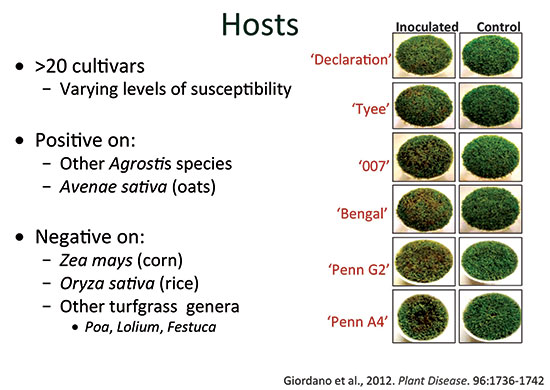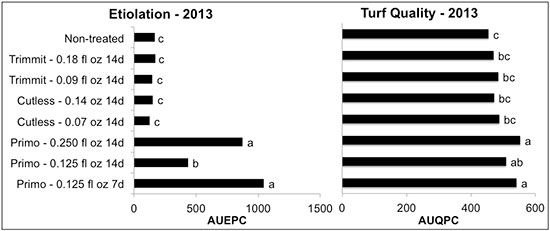What we know about bacterial diseases of turfgrasses

Figure 1: Creeping bentgrass putting green turf exhibiting etiolation symptoms as a result of infection with Acidovorax avenae. Symptoms include abnormal elongation of turfgrass stems and leaves that develop rapidly overnight.
Concerns about bacterial etiolation (Figure 1) and decline exploded in the golf course industry more than five years ago. While etiolation had been observed for years, the abnormal elongation sometimes observed in putting greens usually was an unsightly occurrence that developed during wet conditions and rarely resulted in turf loss.
Those concerns in 2010 and 2011 were not narrowly focused on widespread etiolation, but also on the mass turfgrass decline that followed etiolation symptoms during environmental stress periods. The rapid rise of the conditions caused considerable controversy because the tools that superintendents normally use to combat turfgrass diseases provided little to no control.
Seeing the need across the industry, research teams from multiple universities responded with projects geared toward understanding current management practices and their impact on developing bacterial diseases. While many questions still exist surrounding the outbreak in 2010-2011, researchers now have some answers on how to limit these problems.
Is bad bacteria on my course?
It’s estimated that a single gram of soil can contain up to 1 billion bacteria, most of which are benign or beneficial. Bacterial pathogens on turf are relatively rare, but the pathogenic species of interest tend to be cosmopolitan, meaning they may be found in any number of environments and are likely present to some degree in just about all turfgrass stands. Only when conditions are conducive and levels of inoculum exceed disease-causing thresholds do they become pathogenic on our greens, tees and fairways. The only way to truly know which bacteria species is causing a problem on your course is to send it to a reputable diagnostic lab, which will conduct a thorough analysis of the signs and symptoms and then undertake the laborious process of isolation and characterization.
Thousands of microscopic bacterial species live in turfgrass systems, so the job of discerning which one is the cause of a disease can be challenging. First, we must isolate the most prevalent bacterium from the samples. Diagnostic labs use a technique known as serial dilution to detect organisms in high enough abundance and discard those in low numbers living on or within diseased turf plants. Once a few viable candidates emerge in culture media they are grown and later tested for their ability to infect healthy turfgrass plants.
Using these basic techniques, certain species of Xanthomonas have been well characterized as turf pathogens. These cause bacterial wilt on Poa annua as well as older vegetative cultivars of creeping bentgrass (Agrostis stolonifera) such as Toronto. Only recently have we characterized new hosts for Xanthomonas species, including newer cultivars of creeping bentgrass and perennial ryegrass.
Beginning in 2009, isolation and DNA sequencing found a “new” bacterial turf pathogen in the Acidovorax genus from infected creeping bentgrass samples taken throughout the Transition Zone and much of the mid-Atlantic region. This sparked the research efforts to better understand the threat bacteria pose to high-value turf areas across the country.
Different species, different impact?
An early objective of the initial research on Acidovorax was to determine if the disease was specific to particular turf species as well as individual bentgrass cultivars. Only moderate-to-light infection symptoms occur when Acidovorax is inoculated onto Lolium, Poa and Festuca species. All Agrostis species (stolonifera, tenuis, canina) are susceptible, and all cultivars of creeping bentgrass (A. stolonifera) are susceptible to Acidovorax to some extent.

Figure 2: Cultivar inoculations of creeping bentgrass with Acidovorax avenae subsp. avenae (isolate MSU4). Note the varying disease severity, with cultivars such as Declaration, Tyee and 007 exhibiting significantly less disease symptoms than Penn G2 and Penn A4. Plants were kept in a growth chamber at ~86°F with high relative humidity. Pictures taken 14 days post inoculation.
There are, however, some significant differences in the susceptibility of Declaration and Tyee when compared to the other cultivars (Figure 2). Research done at the University of Rhode Island by Nathaniel Mitkowski, Ph.D., confirmed similar results with several other cultivars of creeping bentgrass. These results showed the non-specific nature of Acidovorax and its ability to infect creeping bentgrass. However, recommendations regarding particular cultivars to turf managers battling the disease are unwarranted until extensive field studies can confirm truly resistant/tolerant cultivars.
The problem became more complex as researchers investigated more samples from around the country. Not only was Acidovorax causing etiolation and decline symptoms on creeping bentgrass putting greens, but in some cases our old friend Xanthomonas was found, either alone or in tandem with Acidovorax, complicating the matter and confusing researchers even more. Inoculations with Xanthomonas translucens resulted in etiolation symptoms on creeping bentgrass putting green turf, and isolations of this bacterium also have been widely distributed in recent years.
Biostimulants, PGRs and fertilization
Etiolation symptoms perplexed many superintendents and researchers because the rapid overnight growth associated with the disease was difficult to explain. Superintendents often encounter fungal pathogens that cause chlorosis (i.e., yellowing), dieback, and/or thinning, but what is it about bacterial infection that results in rapid growth? And why are only individual turfgrass plants infected?
Symptoms intensified at some locations in areas where biostimulants and plant growth regulators (PGRs) were applied, particularly in overlapping areas that received double the application rate. Many biostimulant products contain plant hormones and nutrient packages that can impact plant physiology so as to cause abnormal growth, and their use has skyrocketed in the past decade. In addition to plant hormones, some biostimulants also claim to stimulate the microbial community within the soil, or even contain beneficial microbes, so their use could also stimulate Acidovorax or Xanthomonas bacteria.
Seeing the potential relationship, researchers at North Carolina State University decided to examine how selected biostimulant applications impact bacterial etiolation development. First, multiple biostimulants were selected by carefully examining application records from golf courses in mid-Atlantic and southeastern U.S. that submitted etiolation samples. Next, they tested the most frequently used biostimulants alone and in combination with multiple rates of trinexapac-ethyl (i.e., Primo Maxx, Syngenta Crop Protection) applications, as both biostimulants and growth regulators are typically applied in conjunction to manage creeping bentgrass during summer stress periods. Biostimulants tested across three years included Knife Plus (Floratine), CytoGro (BioPro Technologies), Astron (Floratine), BioMax (Harrells) and PerkUp (Floratine). All were applied according to label specifications. Interestingly, none of the biostimulants tested had a significant effect on bacterial etiolation development, and results were consistent across all three years, regardless of whether the biostimulant was mixed with Primo Maxx.
The Primo Maxx effect
The more interesting side of the previous study was the effect of Primo Maxx on bacterial etiolation. Primo Maxx was speculated as a cause of etiolation symptoms on annual bluegrass well before the outbreaks on creeping bentgrass in 2010-2011, but the rarity of the condition limited researchers’ ability to determine the true effect. Interestingly, Primo Maxx did have a significant effect on bacterial etiolation in the previous study, but effects were different depending on the bacterium (i.e. Acidovorax vs. Xanthomonas) causing etiolation symptoms.
In the fall of 2011, when etiolation was observed to be caused by Xanthomonas, Primo Maxx applications (0.125 fl. oz. per 1,000 sq. ft. every 14 days and seven days) significantly reduced bacterial etiolation symptoms compared to non-treated areas (Figure 2). However, when the same treatment structure was applied during the summer of 2012 and 2013, when Acidovorax was causing bacterial etiolation, researchers observed significantly higher bacterial etiolation where Primo Maxx (0.125 fl. oz. per 1,000 sq. ft. every 14 days and seven days) was applied (Figure 2; 2012 data not shown). Etiolation was highest in areas that received more frequent applications (i.e., seven days versus 14 days). Another interesting note regarding all three years of the study: Regardless of the bacterium causing etiolation, the turf quality of Primo Maxx-treated plots always was significantly better than the non-treated control, meaning that as long as etiolation symptoms were mowed off with daily mowing, researchers saw no detrimental effects as a result of increased bacterial etiolation.

Figure 3: Impact of Primo Maxx applications on bacterial etiolation caused by Xanthomonas translucens (left) or Acidovorax avenae (right). Primo Maxx applications were applied at the designated rate (per 1,000 sq. ft.) and frequency. Area under progress curves values are shown for etiolation in Fall 2011 (Xanthomonas) and Summer 2013 (Acidovorax). Letter designations represent significant differences at the 0.05 probability level.
Seeing the relationship between Primo Maxx applications and etiolation symptoms, the researchers decided to test additional PGRs against bacterial etiolation caused by Acidovorax avenae, as additional modes of growth regulation were suspected of having variable effects on the symptom development. Flurprimidol (i.e., Cutless, SePro Corp.) and paclobutrazol (i.e., Trimmit, Syngenta Crop Protection) are known as early-GA-biosynthesis inhibitors, while Primo Maxx is considered a late-GA-biosynthesis inhibitor. In 2013 and 2014, researchers evaluated multiple rates of Primo Maxx (0.125 fl. oz. per 1,000 sq. ft. and 14 days and 0.250 fl. oz. 14 days), Cutless (0.07 oz. per 1,000 sq. ft. 14 days and 0.14 oz. per 1,000 sq. ft. 14 days), and Trimmit (0.09 fl. oz. per 1,000 sq. ft. 14 days and 0.18 fl. oz. per 1,000 sq. ft. 14 days) on creeping bentgrass inoculated with Acidovorax avenae. Not surprisingly, Primo Maxx applications increased etiolation symptoms similarly to those seen in the previously mentioned study, and reducing the same application from seven days to 14 days significantly reduced symptoms (Figure 3). However, both Cutless and Trimmit applications at both rates had reduced etiolation symptoms no different than the non-treated control, indicating that the alternate mode of action provided by these compounds was able to limit etiolation caused by the Acidovorax bacterium (Figure 3).
And while Cutless and Trimmit may have provided a reduction in etiolation symptoms throughout the season, Primo Maxx applications still provided the best turf quality when etiolated plants were removed through daily mowing. This was surprising, because researchers thought the continued etiolation would have resulted in bacterial decline of Primo Maxx-treated plots. Trimmit and Cutless applications did cause some phytotoxicity discoloration early in the season. While the discoloration dissipated as the season progressed, this can be a concern when applying early GA-biosynthesis inhibitor PGRs.
Based on these results, questions still surround the use of combination PGR products. It may be possible to combine different modes of action to achieve the improved turf quality associated with Primo Maxx applications while limiting etiolation development through the addition of Cutless or Trimmit. Also available is a newer PGR in prohexadione calcium (i.e., Aneuw, Nufarm Americas), which has a similar mode of action to Primo Maxx. Future research will improve our knowledge of how all of these products, alone and in combination, impact etiolation caused by both Acidovorax and Xanthomonas.
Fertilization effects
Along with PGRs, anecdotal evidence from golf course superintendents struggling to combat etiolation point to certain fertilization effects on disease outbreaks. One in particular is the effect of ammoniacal forms of nitrogen (N), most notably ammonium sulfate, and the potential for disease flareups when used.
In order to confirm or disprove this observation, field studies were set up to investigate the effects of ammonium sulfate applications at higher (0.2 lbs N per 1,000 sq. ft. 14 days) and lower (0.1 lbs N per 1,000 sq. ft. 14 days) rates on stands of creeping bentgrass inoculated with the Acidovorax bacterium, as well as sites with naturally occurring infection. Applications of ammonium sulfate consistently rank among the top treatments for etiolation severity in several field studies, although the results are not always statistically significant. When compared to other nitrogen carriers such as urea, treatments of ammonium sulfate, particularly at the higher application rate of 0.2 lbs N per 1,000 sq. ft., showed elevated outbreaks of etiolation symptoms.
While a few simple studies have demonstrated this effect, many questions remain regarding nutritional components of the etiolation phenomenon in turfgrass, especially as it relates to bacterial infection. One hypothesis revolves around the acidifying properties of ammonium sulfate, which could be encouraging a more conducive environment for Acidovorax avenae, allowing for an increased proliferation and activity of the pathogen during times of environmental and mechanical stress on the plants.

Figure 4: Impact of plant growth regulator applications on season-long bacterial etiolation (Acidovorax avenae) and turf quality observed in 2013. Product applications were applied at the designated rate (per 1,000 ft2) and frequency. Area under progress curve values are shown for etiolation (AUEPC) and turf quality (AUQPC). Letter designations represent statistical differences at the 0.05-probability level.
Recommendations
There still are questions regarding the development of bacterial etiolation and/or decline, including how these infectious bacteria contribute to the rapid growth overnight. A similar disease — called foolish seedling — occurs on rice, in which a fungus, Fusarium fujikuroi, produces a gibberellin hormone that causes infected plants to grow taller than the surrounding individuals. The initial research of gibberellin plant hormones developed as a result of this particular disease. It was only later that scientists discovered gibberellins as naturally occurring hormones in plants. There also are numerous bacteria capable of synthesizing gibberellins, and based on recent research, it’s likely that Acidovorax avenae does as well. Researchers currently are working to confirm this theory. In the meantime, there are some recommendations for managing bacterial etiolation in creeping bentgrass putting greens.
- Try to get an accurate diagnosis by a university laboratory that is capable of identifying the bacteria involved. Knowing which bacteria are present can help in formulating a management plan for the future.
- Minimize plant stress, because bacterial decline symptoms identified in 2010-2011 always were associated with environmental stress periods.
- Raise mowing heights to avoid scalping etiolated plants, and support turf health through regular fertilization and irrigation.
- When questioning effects of a chemical application on symptoms, utilize a test area for applications. It’s best to look at products individually, because applying several products in a single mix-tank creates difficulty in drawing conclusions regarding specific applications. Adjusting growth regulator programs to include early-GA inhibitors like Cutless and Trimmit can help, but some phytotoxicity is observed with these applications.
We learned a lot from the 2010 and 2011 outbreaks. As with any emerging pest, especially in a case involving microorganisms from a different kingdom, it takes time to understand and develop new management practices. Continued research will provide additional information and potential management strategies.
Joseph Roberts, Ph.D., is a turfgrass pathologist at the University of Maryland, and Paul Giordano, Ph.D., is a technical specialist in Canada for Bayer Environmental Science. Reach Joseph Roberts at robertsj@umd.edu for more information.
Acknowledgements
Funding for this work was provided by the United States Golf Association, the Michigan Turf Foundation, Project GREEN, and Syngenta Crop Protection.
photos courtesty Joseph Roberts









